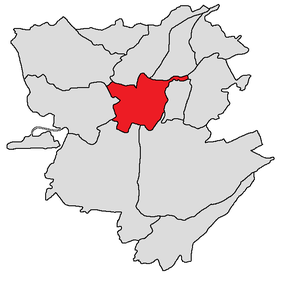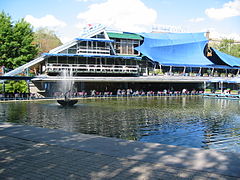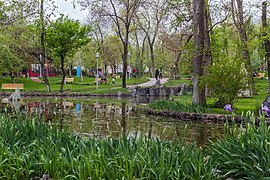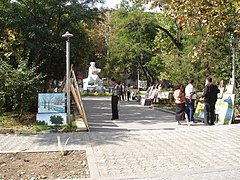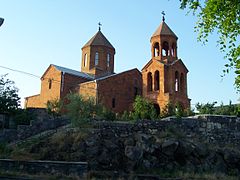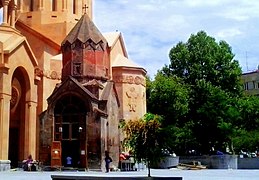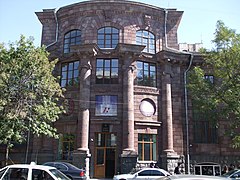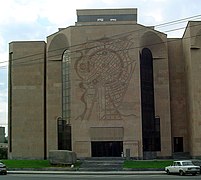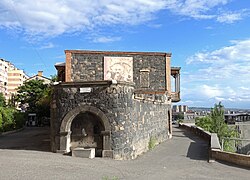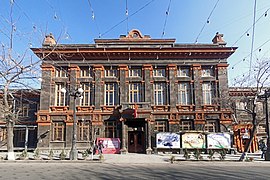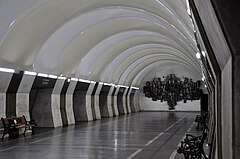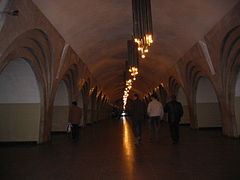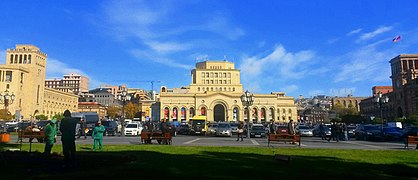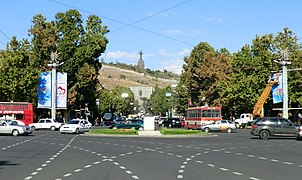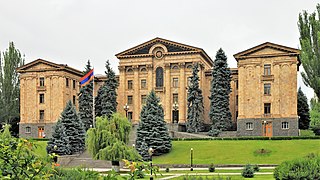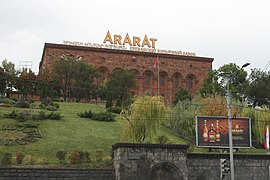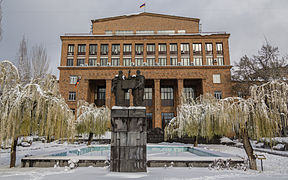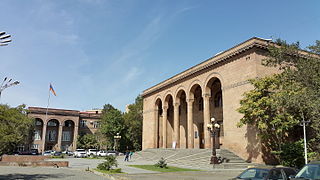Kentron
|
Kentron (Կենտրոն) district of Yerevan |
|
|---|---|
| Coordinates | 40 ° 10 '41 " N , 44 ° 30' 47" E |
| height | 995 m |
| surface | 14.2 km² |
| Residents | 125,453 (2011) |
| Population density | 8835 inhabitants / km² |
| Website | yerevan.am/en/districts/kentron |
| structure | |
| quarter |
Noragjugh, Pokr Kentron, Nor Kilika, Kond, Dzoragjugh, Ajgestan |
| politics | |
| mayor | Avet Poghosjan |
Kentron ( Armenian Կենտրոն վարչական շրջան ) is one of the twelve districts of Yerevan , the capital of Armenia . It includes the city center, the economic and political center of the city. The 2011 census showed a population of 125,453.
etymology
The word kentron literally means center in Armenian and has the same etymological roots as the German word, namely the ancient Greek κέντρον ( kéntron , "center"). Its western Armenian counterpart is Getron ( Armenian կեդրոն ).
overview
Kentron borders in the west on the districts Adschapnjak and Malatia-Sebastia , in the south on the districts Schengawit and Erebuni , in the east on the district Nor Nork and in the north on the districts Arabkir and Kanaker-Sejtun . The Hrasdan River flows through the western part of the district.
The district is unofficially divided into quarters: Noragjugh ( Armenian Նորագյուղ ), Pokr Kentron ( Armenian փոքր կենտրոն ), Nor Kilika ( Armenian Նոր Կիլիկիա ), Kond ( Armenian Կոնդ ), Dsoragjugh ( Armenian Ձորագյուղ ) and Ajgestan ( Armenian Այգեստան ).
Kond and Noragjugh are among the seven original quarters of ancient Yerevan.
history
After Armenia became part of the Soviet Union in 1920/21, it was the first city in the Soviet Union for which a general plan was drawn up. The "General Plan of Yerevan" by the architect Alexander Tamanyan was confirmed in 1924. It originally envisaged a population of 150,000. The city was quickly transformed into a modern industrial metropolis with over 1 million inhabitants. In addition, new educational, research and cultural institutions were established.
Tamanjan combined national traditions with modern urban constructions. His design envisaged a circular-radial structure that was integrated into the existing city and took over many of the existing streets. Despite this, many historic buildings in the city center (today's Kentron District) were demolished, including churches, mosques, the Safavid fortress, baths, bazaars and caravanserais .
Over the years, Kentron became the most developed district of Yerevan, which led to a significant development difference to the other districts of the city. Most of the educational, cultural and research facilities were concentrated in the Kentron district.
Parks
The English Park ( Armenian Անգլիական այգի ⊙ ) was laid out in 1860 and was the only public park in Yerevan until 1920. In 1910 it was significantly redesigned. The first football game in Armenia took place in this park in 1920, when a team from Yerevan and one from Alexandropol played together. After Armenia became part of the Soviet Union, the park was named after the Baku commune . After the collapse of the Soviet Union and the independence of Armenia, it got its name back. There are many monuments and water features in the park.
The Ringpark ( Armenian Օղակաձեւ Զբոսայգի ⊙ ), also a youth park since 2005, extends from the Cathedral of Saint Gregory the Illuminator in the south over 5 km to Lake Poplawok in the north. There are numerous statues, including for Alexander Sergejewitsch Griboyedow , Andranik Ozanian , Vardan Mamikonjan , Yeghische Tscharenz , Tigran Petrosjan , Mikajel Nalbandjan , Armen Tigranjan , Fridtjof Nansen , Avetik Issahakjan and Wahan Terjan .
The Lovers' Park ( Armenian Սիրահարների զբոսայգի ⊙ ) from the 18th century covers 2.5 hectares. The park was originally called Kosernpark after the Kosern district in Yerevan. In 1949 it was redesigned and given the name Pushkin Park . In the late 1970s, it was renamed Friendship Park in honor of the friendship between the peoples of the Soviet Union. After the collapse of the Soviet Union and the independence of Armenia, the Yerevan city council decided to give the park its current name, as it had become a popular place for lovers for walks since the second half of the 20th century. From 2005 to 2008 the park was redesigned based on designs by the French-Swiss architect Pierre Rambach (1925–2003). There is an open-air café and a 215-seat amphitheater that shows films, gives readings and gives concerts. In 2010 a statue for Geworg Emin was erected.
The monument complex Zizernakaberd ( Armenian Ծիծեռնակաբերդ ⊙ ) was built from 1965 to 1968 on the hill of the same name over the river Hrasdan to commemorate the genocide of the Armenians in 1915. In the 1990s, an underground museum was built and a memorial wall was erected.
The Khachatur Abovyan Park ( Armenian Խաչատուր Աբովյանի Պուրակ ⊙ ) was named after the father of modern Armenian literature Khachatur Abovyan . The park consists of a triangular green area and the circular inner area of a roundabout formed by Abowjan Street, in the middle of which there is an Abowjan monument.
Other parks in the district Kentron are the Komitaspark ( Armenian Կոմիտասի անվան զբոսայգի ⊙ ), the Schahumjanpark ( Armenian Շահումյանի զբոսայգի ⊙ ) and the Missak-Manuschjani Park ( Armenian Միսաք Մանուշյանի անվան այգի , formerly Maschtozpark Armenian Մաշտոցի պուրակ ⊙ ).
Religious architecture
The Church of Our Lady Sorawor , or Sorawar Church for short ( Armenian Երևանի Սուրբ Անանիա Առաքյալ անապատ ⊙ ) dates back to the 17th century. The three-aisled basilica without a dome is kept simple inside and out. On the flat areas of the outer walls there are kachkars from the 17th century. Today's church complex was built in 1693/1694 on the foundations of the monastery that was destroyed in the great earthquake of 1679. During the times of the Armenian SSR , the building complex served various non-church purposes. In 1970, however, it was returned to the church and completely renovated.
The Saint Sarkis Cathedral ( Armenian Սուրբ Սարգիս Մայր Եկեղեցի ⊙ ) was built between 1835 and 1842, replacing previous buildings from early Christian times. In 1972 a comprehensive renovation took place according to plans by the architect Raphael Sarkisowitsch Israelian . The facade was clad with orange ani - tuff and provided with triangular niches
The Katoghike Church ( Armenian Կաթողիկե Սուրբ Աստվածածին եկեղեցի ⊙ ) was built in 1264. It is believed to be the only church in Yerevan to survive the great earthquake of 1679. From 1693 to 1695 it was built over with a large, domed three-nave basilica. When the basilica was demolished in 1936 in favor of housing and a linguistic institute, the old church reappeared. After protests by the population, at least the small church with a floor area of 5.4 × 7.5 m was preserved.
The Blue Mosque ( Armenian Կապույտ մզկիթ ⊙ ) is the only mosque in Armenia that is still in use. The building complex was built in 1765/1766. In 1827 it was the most important of the eight mosques in Yerevan. In 1931 the Soviet administration closed the mosque and housed the city museum here. As a result of the Nagorno-Karabakh conflict , almost all Muslims left Armenia for Azerbaijan between 1988 and 1991. Nevertheless, after the collapse of the Soviet Union and the independence of Armenia, the mosque was used religiously again. In 1995 the government of Iran acquired the building and had it converted into a Shiite mosque. A new building was built for the city museum.
The St. John the Baptist Church ( Armenian Սուրբ Հովհաննես Մկրտիչ Եկեղեցի ⊙ ) is a three-aisled basilica. It was built in 1710 on the site of a medieval church that was destroyed in the great earthquake of 1679. In the 1980s, the church was allowed to be completely renovated. The outer walls were clad with tuff and inside, the floor was covered with marble. The church also received a bell tower.
The Cathedral of Saint Gregory the Illuminator ( Armenian Սուրբ Գրիգոր Լուսավորիչ մայր եկեղեցի ⊙ ) was built from 1997 to 2001. It is the largest cathedral in the Armenian Apostolic Church. The cathedral is a complex of three churches: the main church with 1700 seats, and the chapels for Trdat III. the King and Ashes of the Queen with 150 seats each. The main church is 54 m high to the top of the cross. The bell tower has more than 30 arches.
The Sankt-Annen-Kirche ( Armenian Սուրբ Աննա Եկեղեցի ⊙ ) opened in 2015. The cross-shaped building has a dome. The bell tower is above the entrance.
Cultural institutions
The Armenian National Library ( Armenian Հայաստանի ազգային գրադարան ⊙ ) goes back to the library of the Yerevan High School founded in 1832, which was named after Alexander Myasnikov during the Soviet period from 1925 to 1990 . The neoclassical main building was built in 1939 according to plans by the architect Alexander Tamanjan . Among the 6.3 million media, Urbatagirk, printed in Venice in 1512, is the oldest printed work in the Armenian language.
The Armenian National Gallery ( Armenian Հայաստանի ազգային պատկերասրահ ⊙ ) is the largest art collection in Armenia. The building on the Republic Square, which was completed in 1977, was designed by Mark Grigorian and Eduard Sarapjan . In 1921, dozens of works from an exhibition by Armenian artists formed the basis of the collection. The collection now includes around 26,000 works from ancient Urartian frescoes to medieval Armenian church art and modern art by Armenian, Russian and Western European artists.
The Yerevan Opera Theater ( Armenian Ա. Սպենդիարյանի անվան օպերայի և բալետի ազգային ակադեմիական թատրոն , Armenian National Academic Theater of Opera and Ballet "Aleksandr Spendiarjan" ' ⊙ ) was built according to plans by the architect Alexander Tamanjan and on January 20, 1933 with a performance by Almast in Armenian, the only opera by the Armenian composer Aleksandr Spendiarjan . Shortly afterwards a ballet was founded; In 1935, the first ballet performance was Peter Tchaikovsky's Swan Lake . The Opera Theater has two halls: the Aram Khachaturyan Concert Hall with 1,400 seats and the National Opera and Ballet Theater Aleksandr Spendiarjan with 1,200 seats.
The Aram Khachaturyan House ( Armenian Արամ Խաչատրյանի տուն-թանգարան ⊙ ) is a house that the composer Aram Khachaturian has converted into a museum . Khachaturyan lived in the house when he visited Yerevan. In the 1970s, according to plans by the architect Edward Altunjan, it was undeveloped into a museum. Khachaturyan gave the museum manuscripts, letters and other memorabilia. In the multi-storey house there is a concert hall with a Bechstein grand piano, in which concerts take place regularly.
The Matenadaran ( Armenian Մատենադարան ; full name in Armenian Երևանի Մեսրոպ Մաշտոցի անվան Մատենադարան , Mesrop Mashtots Institute for Ancient Manuscripts' ⊙ ) is the central archive for ancient Armenian manuscripts. The collection goes back to the archives of the Catholic of the Armenian Apostolic Church in Etchmiadzin . The Soviet authorities expropriated it in 1920 and brought it to Moscow. In 1939 it came back to Yerevan. Between 1945 and 1957 a new building was built for the archive. It preserves 17,000 manuscripts and 30,000 other documents. The Armenian collection alone includes 2500 manuscripts with Armenian illumination .
The Yerevan State Puppet Theater Howhannes Tumanjani ( Armenian Երևանի Հովհաննես Թումանյանի անվան Պետական Տիկնիկային Թատրոն ⊙ ) was opened on June 1, 1935 by the director Sofja Bedschanjani, the painter Geworg Arakeljan and the actors Pawlos Borojan and Araksja Arabjani. Waria Stepanjan became the first director of the theater located in the hall of the Cathedral of St. Gregory the Illuminator. In 1938 the puppet theater was named after the Armenian poet Howhannes Tumanjan . The puppet theater was closed in 1950, but reopened on July 27, 1957 under Jerwand Manarjan in the house at Leninallee 43. The puppet theater has been located at its current location on Sajat-Nowa-Allee since 1975. In the theater there is also the Pawlos Borojan Puppet Museum with around 200 exhibits.
The Komitas Chamber Music Hall ( Armenian Կոմիտասի անվան կամերային երաժշտության տուն ⊙ ) was built according to plans by the Armenian architect Stepan Kjurktschjan and opened in 1977. The outer shape is reminiscent of a three-aisled Armenian basilica. The walls are decorated with traditional Armenian ornaments. At the rear there is a large water basin with a fountain. Inside, in addition to the entrance hall, vestibule and foyer, there is a concert hall with 200 seats with a cantilevered ceiling and no structural separation between the orchestra and the audience. Interior walls and chandeliers were also designed by the architect Steoan Kjurktschjan. The organ was designed on the model of Dutch organs from the 17th century to play baroque music. It was one of the few organs used in the Soviet Union. The 4000 pipe instrument was installed in 1979 and renovated in 2007.
The Armenian Historical Museum ( Armenian Հայաստանի պատմության թանգարան ⊙ ) was founded on September 9, 1919 by the Armenian National Assembly and opened on August 20, 1920. It has has departments for archeology, numismatics, ethnography, modern history and restoration. The original collection included 15,289 objects. In 1935, two museums were founded: today's Armenian National Gallery and today's Museum of Literature and Art, Yeghische Charenz. Construction work on the current building on Republic Square began in the 1950s and ended in 1977 with the completion of the National Gallery. In 1978 the State Museum of Ethnography was founded. The collection is constantly being supplemented by archaeological finds from all over Armenia and comprised around 400,000 objects in 2018.
The Cafesjian Center of the Arts ( Armenian Գաֆէսճեան արվեստի կենտրոն ⊙ ) is located in and around the Yerevan Cascade , a monumental limestone staircase with multi-tiered waterfalls. The Cafesjian Museum Foundation was founded in April 2002 by the US-Armenian lawyer and patron Gerard Cafesjian and the Armenian government, which made the half-finished cascade available as building site. The museum, which opened in November 2009, offers a wide range of exhibitions in line with the vision of its founder, Cafesjian. Cafesjian's collection of modern art forms the basis of the exhibits. In addition to the exhibition, there are lectures, film screenings, concerts and many educational offers. In the outdoor area, works from the Cafesjian sculpture garden are shown.
In 2005 the Yerevan Historical Museum ( Armenian Երևանի Պատմության Թանգարան ⊙ ) moved into its current building, attached to the Yerevan City Hall . Previously, it was housed in the buildings of the Yerevan Fire Station, the Blue Mosque, the Hripsimjan Girls' High School and, finally, School No. 1. In 2017, the collections comprised more than 94,000 objects, divided into archeology, ethnography, numismatics, fine arts, writings and photography.
The monument complex commemorating the victims of the Armenian genocide in 1915, " Zizernakaberd " ( Armenian Հայոց ցեղասպանության զոհերի հուշահամալիր ⊙ ) is enthroned on a hill. The complex, built between 1966 and 1968, consists of a 44 m high obelisk, twelve pylons around an eternal flame, a 100 m long wall with the names of the cities and villages in which victims of the genocide lived and the Armenian Genocide Museum, which opened in 1995.
The Sergei Parajanov Museum ( Armenian Սերգեյ Փարաջանովի թանգարան ⊙ ) honors the Soviet-Armenian director and artist Sergei Parajanov . It was established in 1988. Paradschow himself chose the location and the appearance of the museum. Because of the Spitak earthquake in 1988 and social and economic problems, the museum was only able to open in 1991, a year after the exceptional artist's death. 1,400 pieces are on display in the two-story Caucasian-style building. The museum organizes temporary exhibitions, publications and honorary receptions, among other things for the annual international film festival "Golden Apricot" .
The National Children's Library Chnko Aper ( Armenian Խնկո-Ապոր Անվան Ազգային Մանկական Գրադարան ⊙ ) was founded in 1933 and, after his death in 1935, was named after the Armenian children's author Chnko Aper . In 1980 she moved into a building on Terjan Street near the Swan Lake of the Yerevan Opera Theater. There are 500,000 media units, separate departments for Chinese, Iranian and German children's literature and a reading room with 100 seats.
The Armenian Center for Modern Experimental Art ( Armenian Նորարար փորձառական արվեստի կենտրոնը (ՆՓԱԿ) ⊙ ) was founded immediately after the collapse of the Soviet Union in 1992 by the American-Armenian artist and poet Sonja Balassanian with the help of her husband, the architect and city planner Edward Balassanian. In 1996, rooms in Faustus-von-Byzanz-Allee were rented as a physical center, which were made available free of charge by the Armenian government by decree from 2002 onwards. It started in 1992 with one exhibition a year and developed into a vital center with over 20 events a year. In 1995 the center organized the historically first Armenian pavilion at the Venice Biennale . The following seven pavilions were also designed by the Armenian Center for Experimental Art.
The Moscow Cinema ( Armenian Մոսկվա կինոթատրոն ⊙ ) was built in 1936 on the site of the Peter and Paul Church, which was demolished in November 1930 at the behest of the Soviet authorities . The building in the Soviet-classical style was built according to the designs of the architects Tiran Jerkanjan and Geworg Kotschar , redesigned in 1960 by Geworg Kotschar and Telman Geworgjan and in 1983 received a new facade with motifs from the Soviet films Tschapajew , Pepo , Dawit Bek and The Color of the Pomegranate . Privatized in 1999, it was completely renovated and reopened in September 2000. The cinema has four halls: Large Red Room (352 seats), Small Blue Room (35 seats), VIP (35) and an open-air cinema (not in use). Since 2004 the Moscow Cinema has been the main venue for the annual international film festival "Golden Apricot" .
Opened in 1920, the Nairi cinema ( Armenian Նաիրի ⊙ ) is the oldest cinema in Yerevan. The first Soviet-Armenian film Sare premiered here in 1926 . The current building was built between 1952 and 1954 according to a design by the architect Alexander Tamanjan and has two halls. It is the second largest cinema in Yerevan.
The Yerevan Circus ( Armenian Երևանի կրկես ⊙ ) was built on a site where a temporary wooden circus was already in the 1930s. In 1939 a permanent building was built, which was replaced by a new building in 1962. The house was in dire need of renovation in 2011, was blown up in 2012 and replaced in 2014 by the current building. The dome height is 21 m. There are 1700 spectators.
The Yerevan Cascade ( Armenian Կասկադ համալիր ⊙ ) is a monumental complex of open staircases, cascades and the Cafesjian Center of the Arts with exhibition rooms and a sculpture garden. The facility has been built since 1971 and was partially completed in 1980. The Center for the Arts was built in the second construction phase from 2002 to 2009.
The Yerevan Vernissage ( Armenian Վերնիսաժ ⊙ ) is an open-air art market along Aram and Faustus of Byzantium Streets. It stretches over 350 m from the Republic Square metro station to the Vardan Mamikonyan statue. The market is open on the weekends. The tradition goes back to the 1980s. There are wood carvings, pictures, traditional carpets, coins, medallions, books, jewelry and musical instruments.
Other cultural institutions in the Kentron district are the Gabriel Sundukjani National Academic Theater ( Armenian Գաբրիել Սունդուկյանի անվան ազգային ակադեմիական թատրոն ⊙ ), which opened on February 25, 1922, and the Hakob Paronjani State Musical and Comedy Theater ( Armenian Հակոբ Պարոնյանի անվան երաժշտական կոմեդիայի թատրոն պետական ⊙ ), which in 1937 opened Russian theater Konstantin Stanislavsky ( Armenian Կոնստանտին Ստանիսլավսկու անվան ռուսական պետական դրամատիկական թատրոն ⊙ ) and the 1900 built concert hall Arno Babadschanjan ( Armenian Առնո Բաբաջանյան համերգասրահ ⊙ ).
traffic
The Kentron district is served by a public transport network consisting of buses and trolleybuses.
The only line on the Yerevan Metro has four stations in the Kentron district. From north to south they are: Marshall Baghramjan station ( Armenian Մարշալ Բաղրամյան ⊙ ) Jeritassardakan station ( Armenian Երիտասարդական ⊙ ), Station Square of the Republic ( Armenian Հանրապետության Հրապարակ ⊙ ) and General Andranik station ( Armenian Զորավար Անդրանիկ ⊙ ) .
The road network is shaped by the outlines of the historic city center. Two lanes around the center are Moskauer Strasse, Chandschjanstrasse, Agatangeghossstrasse, Grigor-Lussawortsch-Strasse and Sarjanstrasse. Major feeder roads include Marschall-Baghramjan-Allee, Mjasnikjan-Allee, Tigran-Mez-Allee, Admiral-Issakow-Strasse and Atenkstrasse. Important squares are Republic Square , French Square, Charles Aznavour Square, Sakharov Square and Freedom Square.
economy
In the Kentron district, office and government buildings where banks, government agencies and educational institutions are based predominate. Upscale retail dominates along the main thoroughfare. In addition, here the administration building of the Republic were established Armenia, including the 1985-built Presidential Palace ( Armenian Հայաստանի նախագահի նստավայր ⊙ ) of 1948-1950 for the Central Committee of the Communist Party of the Soviet Union constructed building of the Armenian National Assembly ( Armenian Ազգային ժողով ⊙ ), the headquarters of Armenian Central Bank ( Armenian Հայաստանի Հանրապետության Կենտրոնական բանկ ⊙ ), the National Security Service ( Armenian Հայաստանի Հանրապետության Ազգային Անվտանգության Ծառայություն ⊙ ) and most of the Ministry buildings.
There are a few manufacturing operations, including the Yerevan brandy, wine and liquor factory Ararat ( Armenian Երևանի Արարատ կոնյակի-գինու-ողու կոմբինատ ⊙ ) and the Yerevan Brandy Company ( Armenian Երևանի կոնյակի գործարան ⊙ ), both of which share the same roots called.
education
At the Yerevan State University ( Armenian Երևանի Պետական Համալսարան, ԵՊՀ ⊙ ), founded in 1919 as the Alexandrapol Commercial School, around 13,000 students studied in 2017. The main buildings were erected in the 1950s between Alek-Manukean- and Tscharenzstraße in the northeast of the Ringpark.
The National University of Architecture and Construction of Armenia ( Armenian Ճարտարապետության և շինարարարության Հայաստանի ազգային համալսարան, ՃՇՀԱՀ ⊙ ) was founded in 1921. The main buildings are on Terjan Street, west of Khachatur Abovyan Park.
The Yerevan State Conservatory ( Armenian Երևանի Կոմիտասի անվան պետական կոնսերվատորիա ⊙ ) faces the Armenian State Opera. Almost the entire elite of Armenian music studied at the conservatory, which was founded in 1921.
The Armenian State Pedagogical University ( Armenian Խաչատուր Աբովյանի անվան հայկական պետական մանկավարժական համալսարան ⊙ ) is located on Chandjian Street, southeast of the Ringpark. At the university, which was founded in 1922, ten faculties were studied in 2018. The university museum has an archaeological cabinet and an exhibition on the history of the university.
At the Yerevan State Medical University, founded in 1920 ( Armenian Երեվանի Մխիթար Հերացու անվան Պետական Բժշկական Համալսարան ⊙ ), around 5,000 students studied six courses in 2018. There are 650,000 media items in the university library. The buildings date from the 1930s.
The National Polytechnic University of Armenia ( Armenian Հայաստանի ազգային պոլիտեխնիկական համալսարան ⊙ ) was founded in 1933 and developed into one of the leading technical universities in the Soviet Union with up to 25,000 students in 66 departments in the 1980s. In addition to the buildings west of Khachatur Abowian Park, there were campuses in Gyumri, Vanadzor and Kapan for around 10,000 students in 2018.
At the Yerevan State University for Languages and Social Sciences ( Armenian Երևանի պետական լեզվահասարակագիտական համալսարան ⊙ ), founded in 1935, there were almost 4,000 students in the faculties for interpreting and intercultural communication, for Russian language, literature and foreign languages, and for foreign languages.
The Armenian State Economic University ( Armenian Հայաստանի պետական տնտեսագիտական համալսարան ⊙ ) on Nalbandjan Street north-west of the Ringpark was founded in 1930 and promoted to university in 2004. In 2018 there were around 7,000 students in the Faculty of Management, International Economic Relations, Finance, Marketing, IT and Statistics, as well as Accounting and Audit.
The Armenian National Academy of Sciences ( Armenian Հայաստանի գիտությունների ազգային ակադեմիա ⊙ ) carries out applied and basic research and coordinates the cooperation of scientific institutions. Founded in 1943 as a branch of the Academy of Sciences of the USSR, the academy resides in buildings dating from 1955.
Sports
There are numerous sports facilities in the Kentron district, including football, chess and tennis.
The Wasken Sarkissjan Republican Stadium ( Armenian Վազգեն Սարգսյանի անվան Հանրապետական մարզադաշտ ⊙ ) in the southeast of the Kentron district has been in existence since 1936. The former Dynamo stadium was named in 1999 after the defense minister and former sports teacher Wasken Sarkissian, who was murdered in the same year . The football stadium is the home stadium of the clubs FC Pyunik Yerevan and FC Ulisses Yerevan .
The central house for chess players Tigran Petrosjan ( Armenian Տիգրան Պետրոսյանի անվան Շախմատիստի Կենտրոնական Տուն ⊙ ) with its triangular floor plan is east of the center in Ringpark. The chess grandmaster Tigran Petrosjan laid the foundation stone for the house of the Yerevan chess school in 1970, which was named after him in 1984.
The multi-functional stadium Hrasdan ( Armenian Հրազդան մարզադաշտ ⊙ ) with 55,000 seats, built in 1972, is the home stadium of the football clubs FC Ararat Yerevan and FC Kilikia Yerevan .
The Karen Demirchyan Sports and Concert Complex ( Armenian Կարեն Դեմիրճյանի անվան մարզահամերգային համալիր , short Armenian համալիր hamalir for “complex” ⊙ ) is a large collection of venues along the stairs to the Zizernakaberd Memorial . Completed in 1983, operations had to be stopped in 1985 due to a fire and could only be restarted in 1987. Shortly after his murder, the complex was named after the politician Karen Demirtschjan , who campaigned for the construction. The complex was sold for $ 5.7 million in 2005 to a Russian holding company that had it remodeled for $ 42 million by 2008. Numerous sports and music events take place here.
Web links
![]() Map with all coordinates: OSM | WikiMap
Map with all coordinates: OSM | WikiMap
- Official Kentron District website. In: yerevan.am. Accessed July 11, 2018 .
Individual evidence
- ↑ https://www.yerevan.am/en/districts/kentron/ (accessed January 9, 2020)
